
| From Wyoming Tales and Trails This page: Wheatland, the coming of irrigation and the railroad. |
 |

| From Wyoming Tales and Trails This page: Wheatland, the coming of irrigation and the railroad. |
 |
|
|
|
About This Site |
|
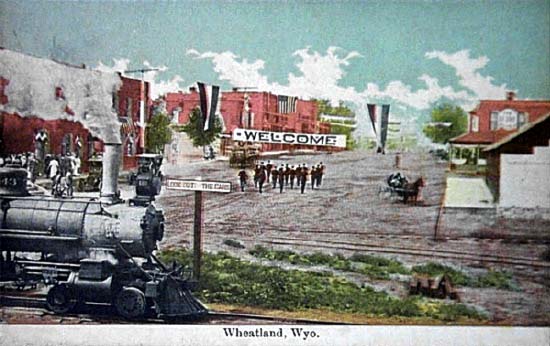 Wheatland, Approx. 1910. Southwest of Guersey, between the Laramie and the Chugwater, lies Wheatland, the county seat of Platte County. Although settlements in present day Platte County date to prior to the Civil War, the county itself is comparatively recent, 1911, when the Legislature is a spasm of county-making added seven counties. A number of towns in the County, such as Hartville, incorporated in 1884; Chugwater; Uva; and Bordeaux are older. The older towns were the centers for ranches such as the Teschemacher and DeBillier Cattle Company at Hubert, Wyoming, organized by Hubert Teschemacher (1850-1907) and Frederic O. DeBellier (1857-1935), the H R owned by George Mitchel located near Uva, the Hunton Ranch at Bordeaux, and James Miton Whitney's ranch at Uva. Nearby, also, was Edward Creighton's ranch founded in the late 1860's to provide beef for the Union Pacific. Until the railroad reached Wheatland, Bordeaux some 15 miles south of present-day Wheatland was the center of commerce for the area. Bordeaux today consist of little more than a railroad crossing.
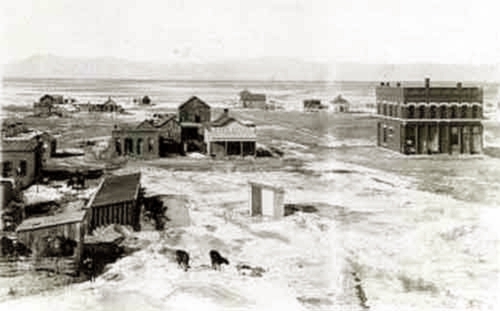 Wheatland, 1890's Bordeaux was founded in 1867 by a former bourgeois at Fort Laramie, James Bordeaux (1814-1878). Bordeaux had received advance word as to the construction of new military roads connecting Fort Laramie, Fort Fetterman and Fort D. A. Russell. He, thus, constructed a road ranch at the intersection of the three roads. The intial building was described by John Hunton as consisting of three small log rooms all connecting with each other. Bordeaux like many an early trapper came from St. Charles outside of St. Louis. After his mother died and his father remarried, he left home at age 12, joining the American Fur Company along the upper Missouri. By 1830, he was working for Pierre Chouteau, Jr. as an engagé for $200.00 a year. By 1845 he was in charge at Fort Laramie. Later Bordeaux was a partner with Joseph Bissonette and had an ownership interest in Fort Bernard near present-day Lingle. Fort Bernard burned down in 1868. The store at Bordeaux was managed by Hugh Whiteside. Whiteside was murdered in the store by a horse thief. Later John Hunton acquired the road ranch. Whiskey sold for twenty-five cents a drink, meals fifty cents and overnight accommodations a dollar. At one time Bordeaux had the road ranch, hotel, post office and store. Eugene Ware in his 1911 Indian War of 1864 described Bordeaux's residence on the North Platte and its owner: It was a large, rambling log building with sod end to it, and additions and outbuildings attached to it, so that it was a sort of wandering, straggling caravansary and store combined. He got to showing me what he had, and then he went into the front of the store-building, where he had some cigars. The doors were all bolted and barred. He got to telling me about his visit to France. The floor in this part of the building was made out of pine logs brought down to a grade with an adz. It happened that I could read his French language, and I expressed myself very much interested, and he told me all about his recent trip to "La Belle France"; and he had a new variety of bitters known as Red Jacket Bitters, of which he was partaking freely. We talked about Indians and Indian matters and Indian habits and Indian customs, and he said that the Indians that had been back of his house had gone off. But I was very much interested in his description of Indian manners and his adventures among them, until it got to be along about one o'clock in the morning. And Mr. Bordeaux again got off onto the subject of his visit to "La Belle France," and he seemed to be very much pleased with the bitters he had and the attention with which I listened to his story. He was a much older man than I, and I was, indeed, very much delighted to hear him talk. All at once he disappeared through the floor, by turning up a plank or puncheon, and the first thing I knew he came back from down below somewhere with two large, musty quart bottles of champagne, and sticking one down in front of me said, "We will drink to La Belle France." I was as much surprised as if the man had dug up a statue of Daniel Webster. The idea of a quart bottle of champagne in that dry, arid, heathen country almost paralyzed me, but I finally said to him that a quart bottle was more than my size, and that I would drink half of one of the bottles with him. I suggested that we split, and each drink half of the same bottle. Thereupon he got two tin cups, and with a hatchet knocked off the head. There in the stillness of night in that country we drank to the health of "La Belle France." I have never seen Mr. Bordeaux since then, but have retained a delicious memory of him and the occasion.[Writer's notes: Red Jacket Bitters was a form of patent medicine advertised as " prepared in pure Bourbon Whiskey, from a combination of over twenty different kinds of roots, barks and herbs, from the originia formula given by the great CHIEF RED JACKET, to Dr. CHAPIN." Red Jacket (1756-1830) was a loyalist Seneca Indian taking his name from a red jacket presented to him by the British.]
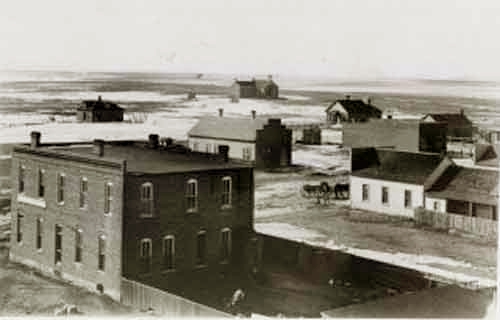 Wheatland, 1890's On the lawn of the Platte County is a statute, not as in the east a monument commemorating Union dead or as in the south Confederate dead, nor, as elsewhere in Wyoming, doughboys from World War I. The statue is of the "Irrigator," and, thus, notes that Wheatland owes its founding to irrigation.
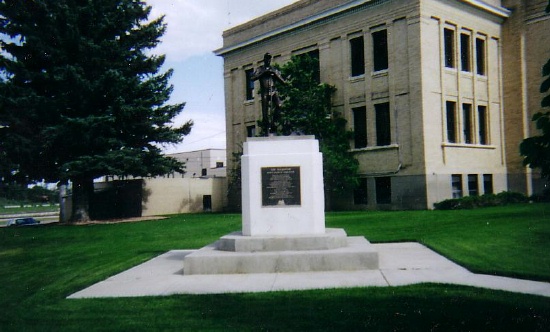 The Irrigator, Platte County Courthouse, Wheatland, 2005. Photo by Geoff Dobson Indeed, even the trees along the streets as depicted in later photos were as a result of "In-Town" irrigation. Irrigation was promoted by the formation of the Irrigation was brought about by the Wyoming Improvement Company organized in 1883 by Andrew Gilchrist, rancher; J. M. Carey; William C. Irvine; Sir Horace C. Plunkett, Irish agriculturist; John W. Hoyt, former Territorial Governor; Morton E. Post, Cheyenne merchant and subsequent Territorial Congressional Delegate; and F. E. Warren, Cheyenne merchant, cattleman, future governor and senator. The Company had control over 58,813 acres. The same year, construction started on the first of its irrigation projects. The city also owes its existence to the related coming of the the Cheyenne and Northern Railroad Company. However, as the railroad progressed northward from Cheyenne, its route constantly changed. Thus, locating the townsite was shooting at a moving target. Originally the town was to called Sybille Colony probably after nearby Sybille Creek and the small settlement of Sibylee to the north of present day Wheatland. Subsequently, the townsite was moved to Rock Lake and was called "Wheatfield." The railroad moved eastward and, again, the town was moved. The railroad surveyed moved yet once more and finally in 1887 Wheatland was born marked by a one-room frame building. Soon a new two-story building at corner of Gilchrist and 9th streets arose. There is disagreement at to the origins of the name "Sybille" and its spelling. John Hunton spells it "Sibylee". Most likely, the name is derived from the name of an early fur trapper and trader Jean "John" Sybille," [also spelled "Sibille"] a partner in the short-lived Sybille, Adams & Co. The company for a short time in the 1840's owned Fort Platte on the Platte river near its confluence with the Laramie. Fort Platte was an unsuccessful competitor of Fort Laramie.
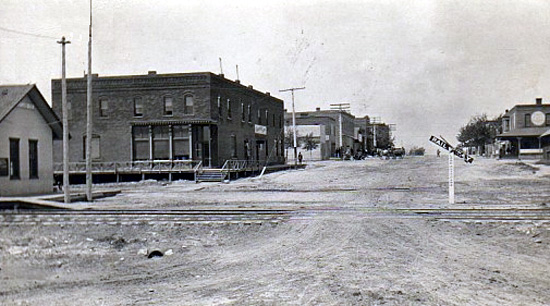 Gilchrist Avenue, looking west, 1908. . The building on the right in the above photo is the Globe Hotel at the intersection of Gilchrist Ave. and 9th Street. The two-story building on the left is the Carey Block. The building on the left at the bottom of the photo is the railway depot. See next photo. The hotel was constructed in 1894 and was ultimately razed in order to construct a parking lot.
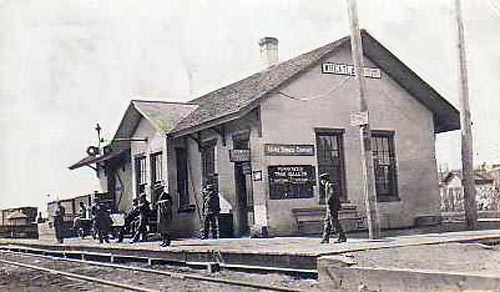 Wheatland Depot The Railroad Depot, located at the east end of Gilchrist Avenue, was constructed in 1895 and is now on the National Register. The Depot closed in 1969. Next page, Wheatland Continued, Uva, Bordeaux. |